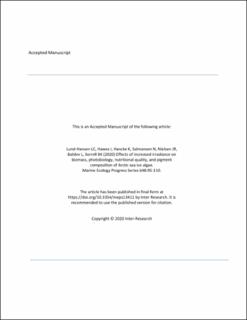| dc.contributor.author | Lund-Hansen, Lars Chresten | |
| dc.contributor.author | Hawes, Ian | |
| dc.contributor.author | Hancke, Kasper | |
| dc.contributor.author | Salmansen, Nicole | |
| dc.contributor.author | Nielsen, Johanne Raakjær | |
| dc.contributor.author | Balslev, Laura | |
| dc.contributor.author | Sorrell, Brian K | |
| dc.date.accessioned | 2021-06-01T06:27:01Z | |
| dc.date.available | 2021-06-01T06:27:01Z | |
| dc.date.created | 2020-11-25T12:28:40Z | |
| dc.date.issued | 2020 | |
| dc.identifier.citation | Marine Ecology Progress Series. 2020, 648, 95-110. | en_US |
| dc.identifier.issn | 0171-8630 | |
| dc.identifier.uri | https://hdl.handle.net/11250/2757123 | |
| dc.description | This is an accepted manuscript version. Embargo until August 27 2021. | en_US |
| dc.description.abstract | Ice algae are key contributors to primary production and carbon fixation in the Arctic, and light availability is assumed to limit their growth and productivity. We investigated photo-physiological responses in sea ice algae to increased irradiance during a spring bloom in West Greenland. During a 14 d field experiment, light transmittance through sea ice was manipulated to provide 3 under-ice irradiance regimes: low (0.04), medium (0.08), and high (0.16) transmittances. Chlorophyll a decreased with elevated light availability relative to the control. Maximum dark-adapted photosynthetic efficiency (ΦPSII_max) showed an initially healthy and productive ice algae community (ΦPSII_max > 0.6), with ΦPSII_max decreasing markedly under high-light treatments. This was accompanied by a decrease in the light utilization coefficient (α) and photosynthetic capacity (maximum relative electron transfer rate), and a decrease in the ratio of mono- to polyunsaturated fatty acids. This was partly explained by a corresponding increase of photoprotective pigments (diadinoxanthin and diatoxanthin), and a development of mycosporine-like amino acids as identified from a distinctive spectral absorption peak at 360 nm. After 14 d, in situ fluorescence imaging revealed significant differences in ΦPSII_max between treatments of dark-adapted cells (i.e. those sampled before sunrise and after sunset), during diel cycles, with clear chronic photoinhibition in high and medium treatments. Data demonstrate the high sensitivity of spring-blooming Arctic sea ice algae to elevated irradiance caused by loss of snow cover. The predicted loss of snow cover on landfast ice will negatively impact ice algae, their potential primary production, and nutritional quality for higher trophic levels. | en_US |
| dc.language.iso | eng | en_US |
| dc.publisher | Inter Research | en_US |
| dc.title | Effects of increased irradiance on biomass, photobiology, nutritional quality, and pigment composition of Arctic sea ice algae | en_US |
| dc.type | Peer reviewed | en_US |
| dc.type | Journal article | en_US |
| dc.description.version | acceptedVersion | en_US |
| dc.rights.holder | Copyright © 2020 Inter-Research | en_US |
| dc.source.pagenumber | 95-110 | en_US |
| dc.source.volume | 648 | en_US |
| dc.source.journal | Marine Ecology Progress Series | en_US |
| dc.identifier.doi | 10.3354/meps13411 | |
| dc.identifier.cristin | 1852179 | |
| cristin.ispublished | true | |
| cristin.fulltext | postprint | |
| cristin.qualitycode | 2 | |
